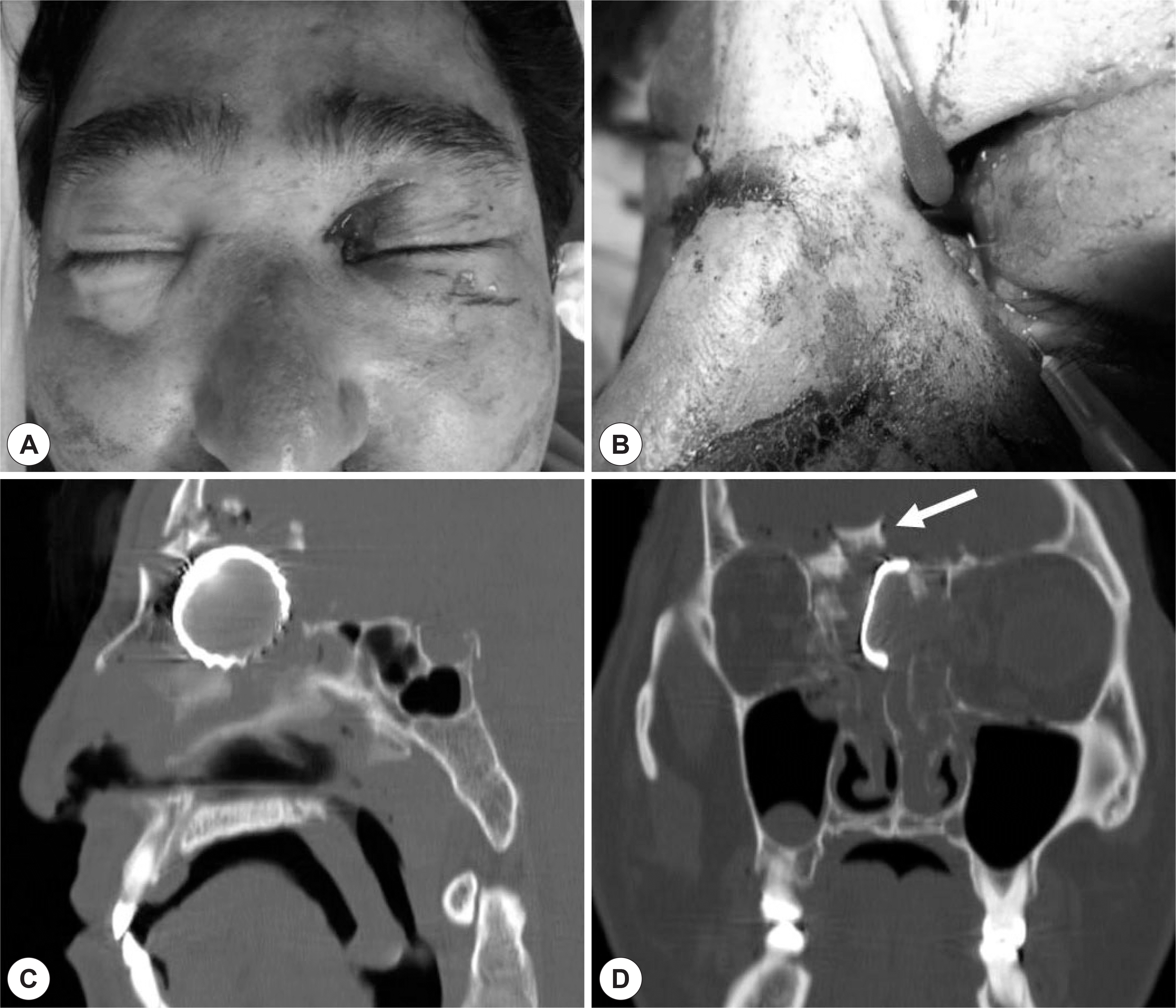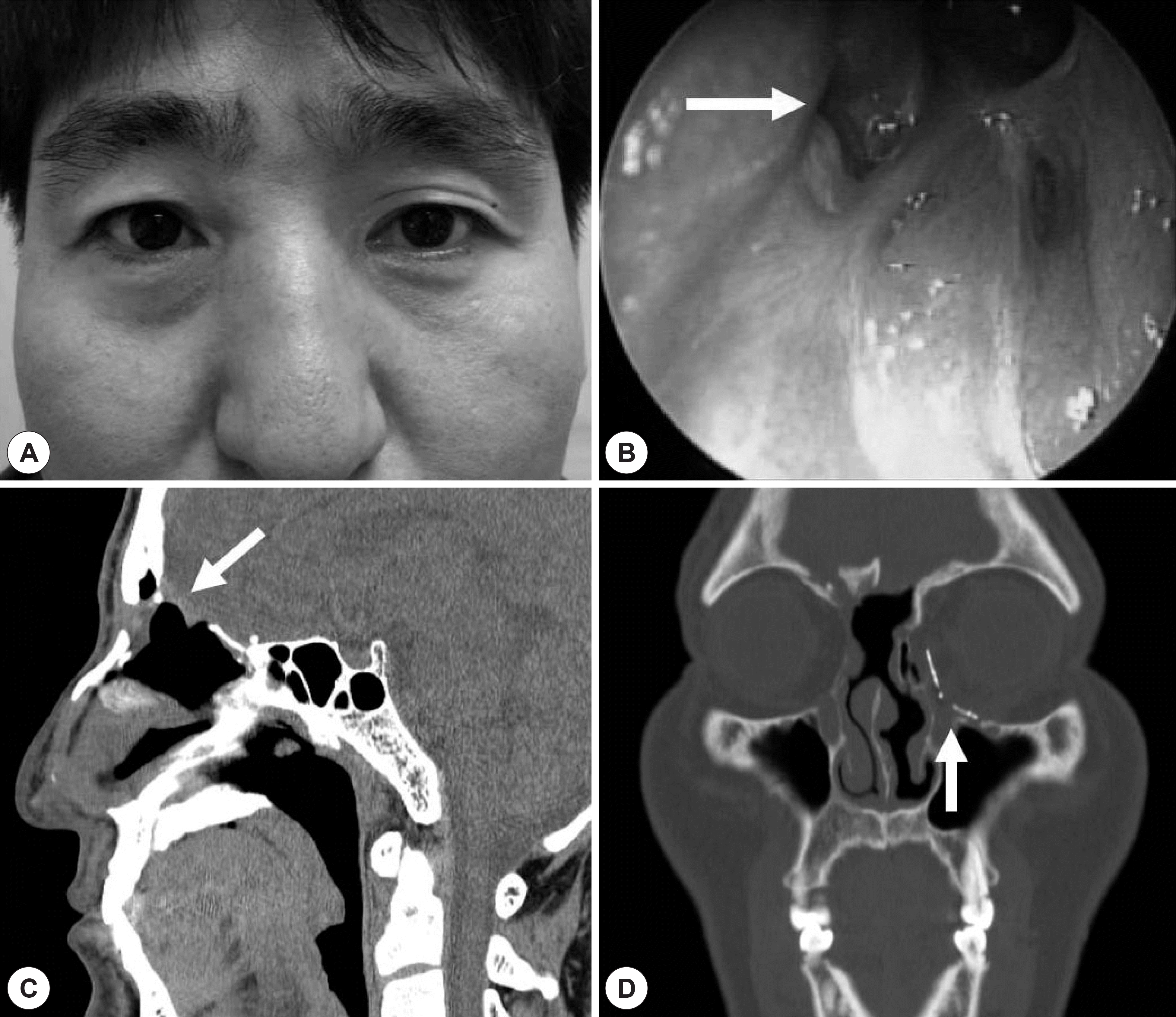Abstract
We report a case of foreign body presence in the ethmoid sinus cavity with anterior skull base fracture and visual loss. A 42-year-old male had an uncertain history of trauma and a penetrating wound near the left medial canthus. Computed tomography imaging showed a 3.0-cm bottle cap penetrating into the anterior skull base. He underwent foreign body removal, canalicular repair, ethmoidectomy, and cerebrospinal fluid leakage repair using packing material. Six months after the initial surgery, a second-stage operation for blowout fracture repair was performed. At the 18-month postoperative follow-up from the initial surgery, the patient had no complaints except anosmia. This is a very rare case of a large, blunt, foreign body penetrating into the anterior skull base without long-term complications after successful removal and skull base repair. Simultaneous repair of cerebrospinal fluid leakage, management of canaliculi injury, and traumatic optic nerve neuropathy should be considered in such cases.
Go to : 
References
1). Brinson GM, Senior BA, Yarbrough WG. Endoscopic management of retained airgun projectiles in the paranasal sinuses. Otolaryngol Head Neck Surg. 2004; 130:25–30.

2). Udwadia RA, Maniar D, Acharya M. A transethmoid transorbital foreign body. J Laryngol Otol. 1994; 108:441–2.

3). Tsao YH, Kao CH, Wang HW, Chin SC, Moe KS. Transorbital penetrating injury of paranasal sinuses and anterior skull base by a plastic chair glide: management options of a foreign body in multiple anatomic compartments. Otolaryngol Head Neck Surg. 2006; 134:177–9.

5). Fallon MJ, Plante DM, Brown LW. Wooden transnasal intracranial penetration: an unusual presentation. J Emerg Med. 1992; 10:439–43.

6). Donald PJ, Gadre AK. Neuralgia-like symptoms in a patient with an airgun pellet in the ethmoid sinus: a case report. J Laryngol Otol. 1995; 109:646–9.

7). Asano T, Ohno K, Takada Y, Suzuki R, Hirakawa K, Monma S. Fractures of the floor of the anterior cranial fossa. J Trauma. 1995; 39:702–6.

8). Cetinkaya EA, Okan C, Pelin K. Transnasal, intracranial penetrating injury treated endoscopically. J Laryngol Otol. 2006; 120:325–6.

9). Dodson KM, Bridges MA, Reiter ER. Endoscopic transnasal management of intracranial foreign bodies. Arch Otolaryngol Head Neck Surg. 2004; 130:985–8.

10). Sharif S, Roberts G, Phillips J. Transnasal penetrating brain injury with a ball-pen. Br J Neurosurg. 2000; 14:159–60.
11). Thomas S, Daudia A, Jones NS. Endoscopic removal of foreign body from the anterior cranial fossa. J Laryngol Otol. 2007; 121:794–5.

12). Gray ST, Wu AW. Pathophysiology of iatrogenic and traumatic skull base injury. Adv Otorhinolaryngol. 2013; 74:12–23.

13). Friedman JA, Ebersold MJ, Quast LM. Post-traumatic cerebrospinal fluid leakage. World J Surg. 2001; 25:1062–6.

14). Emanuelli E, Bignami M, Digilio E, Fusetti S, Volo T, Castelnuovo P. Post-traumatic optic neuropathy: our surgical and medical protocol. Eur Arch Otorhinolaryngol 2014. In press.
15). Kumaran AM, Sundar G, Chye LT. Traumatic optic neuropathy: a review. Craniomaxillofac Trauma Reconstr. 2015; 8:31–41.

16). Levin LA, Joseph MP, Rizzo JF 3rd, Lessell S. Optic canal decompression in indirect optic nerve trauma. Ophthalmology. 1994; 101:566–9.

17). Mine S, Yamakami I, Yamaura A, Hanawa K, Ikejiri M, Mizota A, et al. Outcome of traumatic optic neuropathy. Comparison between surgical and nonsurgical treatment. Acta Neurochir (Wien). 1999; 141:27–30.

18). Yu-Wai-Man P, Griffiths PG. Steroids for traumatic optic neuropathy. Cochrane Database Syst Rev. 2013; 6:CD006032.

19). Beck RW, Cleary PA, Anderson MM Jr, Keltner JL, Shults WT, Kaufman DI, et al. A randomized, controlled trial of corticosteroids in the treatment of acute optic neuritis. The Optic Neuritis Study Group. N Engl J Med. 1992; 326:581–8.
Go to : 
 | Fig. 1.A: Entry wound over the left medial canthus. B: Needle probing showing canalicular injury and medial canthal laceration. C: Sagittal computed tomography (CT) scan showing a bottle cap in the anterior ethmoid sinus with anterior skull base disruption. D: Coronal CT scan showing bilateral medial orbital wall fracture with displacement of the crista galli and cribriform plate (white arrow). |
 | Fig. 2.A: Postoperative 18-month facial photo showing a well healed wound without orbital displacement. B: Endoscopic exam showing repaired anterior skull base without CSF leakage (white arrow). Endoscopic follow-up of the skull base was possible at the outpatient clinic because complete ethmoidectomy was performed simultaneously at the initial surgery. C: Sagittal computed tomography scan showing a well delineated anterior skull base without herniation (white arrow). D: Coronal CT scan showing the orbit wall reconstructed with medpor implant material (white arrow). |
Table 1.
Published cases of anterior skull base injuries with ethmoid and intradural foreign bodies
| Number | Year | Author | Sex/ Age | Size (cm) | Shape | Type of foreign body | Entry point | Route of removal | CSF rhinorrhea | Visual impairment | Postoperative complications | ||
|---|---|---|---|---|---|---|---|---|---|---|---|---|---|
| Preoperative | Intraoperative | Repair method | |||||||||||
| 1 | 1992 | Fallon et al. | F/2 | 7.0 | Sharp | Wooden stick | Endonasal | Craniotomy | None | Yes | Packing | None | None |
| 2 | 1995 | Asano et al. | NS | NS | Sharp | Metallic fragment | Transorbital | External | None | Yes | NS | Permanent† | Visual loss |
| 3 | 2000 | Sharif et al. | M/44 | 14 | Sharp | Ballpoint pen | Endonasal | Craniotomy | Yes | Yes | NS | None | None |
| 4 | 2004 | Brinson et al. | M/15 | 0.5 | Round | Airgun projectile | Endonasal | Endonasal | None | Yes | Septal mucosal graft | None | None |
| 5 | 2004 | Dodson et al. | M/34 | 6.0 | Sharp | Metallic pen | Endonasal | Endonasal | None | Yes | Bone and mucosal graft | None | None |
| 6 | 2006 | Tsao et al. | M/45 | 2.5 | Blunt | Plastic chair glide | Transorbital | Combined* | None | None** | Not performed | Temporary | CSF leakage |
| 7 | 2006 | Cetinkaya et al. | F/4 | 25 | Sharp | Pencil | Endonasal | Endonasal | None | Yes | Packing, lumbar drain | None | None |
| 8 | 2007 | Thomas et al. | M/41 | 0.3 | Round | Airgun projectile | Endonasal | Endonasal | None | Yes | Turbinate mucosal graft | None | None |




 PDF
PDF ePub
ePub Citation
Citation Print
Print


 XML Download
XML Download